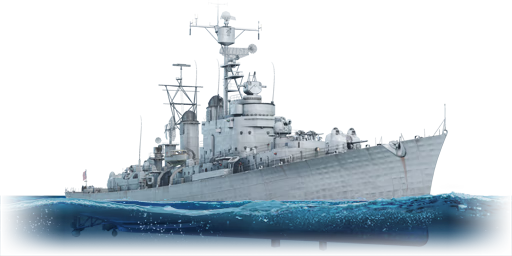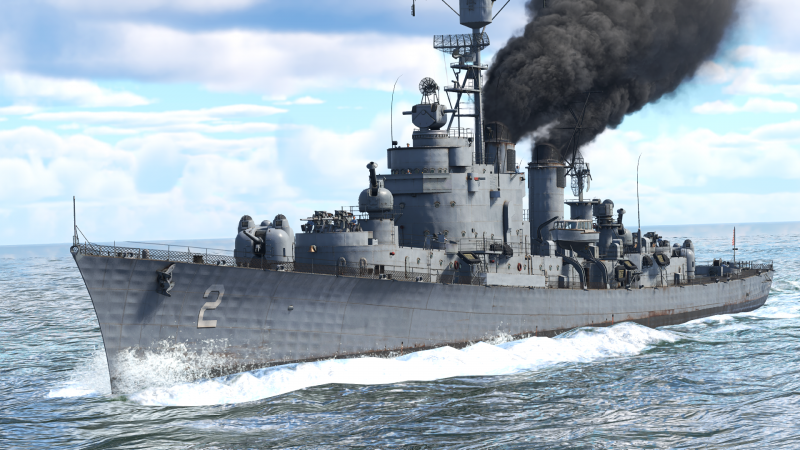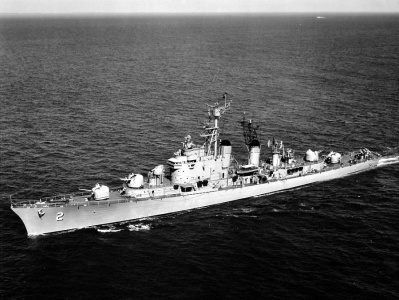USS Mitscher
Contents
Description
The USS Mitscher (DL-2/DDG-35) one of the experimental destroyers of the Mitscher class built for the United States Navy immediately after World War II. Originally designated DD-927, she was laid down on 3 October 1949 by the Bath Iron Works Corporation in Bath, Maine, then reclassified as a lead ship for a new destroyer class on 2 February 1951. The ship was named after Admiral Marc "Pete" Mitscher and was launched on January 26, 1952, by Mrs Marc A. Mitscher, Admiral Mitscher's widow, and commissioned on May 15, 1953. Between 18 March 1966 and 29 June 1968, she was modified to a guided missile destroyer and designated DDG-35, serving until 1978. On 1 June 1978, the USS Mitscher was decommissioned and struck from the Naval Vessel Register, and it was scrapped in July 1980.
Introduced in Update "Ground Breaking", the USS Mitscher is a unique destroyer with fewer gun platforms than prior destroyers but increased lethality. The two 127 mm/54 Mark 18 guns are positioned in a single turret in the bow and stern. The main turrets may be fully traversed, providing excellent coverage. While the ship has only two main guns, which severely limits its burst damage and accuracy when compared to other 127 mm guns, these weaknesses are offset by an extremely fast rate of fire of 40 shells per minute, allowing the USS Mitscher to deal a similar continuous damage output as other destroyers in her rank. Furthermore, the shells fired by the USS Mitscher are heavier and more potent in terms of penetration and explosive content than 127 mm shells from World War II. However, with only two gun mounts, its efficacy is severely hindered if one of these turrets is disabled.
General info
Survivability and armour
Built during the early Cold War to serve as a "Destroyer leader" to be armed with various armaments for different targets, the Mitscher is unusually large. At a whopping 150 m in length and over 4,800 tons of displacement, she even dwarfs the Japanese experimental cruiser Yubari and has a size closer to that of light cruisers.
The Mitscher is barely armoured. The ship only has thin armour to protect the two cannon turrets and a gun shield for Oerlikon autocannons, the ship will attract incoming fire from all gun calibres and take full damage. Her internal modules are unprotected and can be easily damaged, especially her rocket ammo racks that can be easily detonated due to lack of protection.
Mobility
Being a destroyer, the Mitscher is reasonably fast and manoeuvrable, though her large displacement for her class and long length limit her acceleration and agility.
| Mobility Characteristics | |||||
|---|---|---|---|---|---|
| Game Mode | Upgrade Status | Maximum Speed (km/h) | Turn Time (s) | Turn Radius (m) | |
| Forward | Reverse | ||||
| AB | Stock | 61 | 26 | ~133.32 | ~253.44 |
| Upgraded | ___ | ___ | |||
| RB/SB | |||||
| Upgraded | ___ | ___ | |||
Modifications and economy
Armament
Primary armament
The main armament for the Mitscher is two 127 mm/54 Mark 18 autocannons mounted in a single turret at the bow and stern. The main turrets can be fully traversed over 360 degrees and consequently have very good coverage. While there are only two main guns for the ship, which severely limits its burst damage, and has notably worse accuracy compared with other 127 mm guns, these weaknesses are compensated by an extremely fast rate of fire of 40 shells per minute, and thus allows the Mitscher to deal a similar continuous damage output as other destroyers at her BR range. Moreover, the shells fired by the Mitscher are heavier and more powerful than WW2-era 127 mm shells in terms of both penetration and explosive filler.
The Mitscher has three type of shells; an HE shell with similar damage output to other American destroyers, an SAP shell with very good penetration of 156 mm at 5,000 m that is capable of damaging enemy cruisers, and an HE-VT shell that is very useful for engaging aircraft thanks to the gun's wide coverage and fast reload, especially when used with the anti-air radar that the Mitscher is equipped with.
| Penetration statistics | |||||||
|---|---|---|---|---|---|---|---|
| Ammunition | Type of warhead |
Penetration @ 0° Angle of Attack (mm) | |||||
| 1,000 m | 2,500 m | 5,000 m | 7,500 m | 10,000 m | 15,000 m | ||
| HC Mk.41 | HE | 36 | 36 | 36 | 36 | 36 | 36 |
| SP Common Mk.42 | SP Common | 204 | 177 | 140 | 112 | 92 | 70 |
| Mark 41 HC-VT | HE-VT | 36 | 36 | 36 | 36 | 36 | 36 |
| Shell details | ||||||||||||
|---|---|---|---|---|---|---|---|---|---|---|---|---|
| Ammunition | Type of warhead |
Velocity (m/s) |
Projectile mass (kg) |
Fuse delay (s) |
Fuse sensitivity (mm) |
Explosive mass (TNT equivalent) (g) |
Ricochet | |||||
| 0% | 50% | 100% | ||||||||||
| HC Mk.41 | HE | 810 | 31.75 | 0 | 0.1 | 3,440 | 79° | 80° | 81° | |||
| SP Common Mk.42 | SP Common | 810 | 31.75 | 0.01 | 6 | 970 | 48° | 63° | 71° | |||
| Proximity-fused shell details | ||||||||||||
|---|---|---|---|---|---|---|---|---|---|---|---|---|
| Ammunition | Type of warhead |
Velocity (m/s) |
Projectile mass (kg) |
Fuse delay (m) |
Fuse sensitivity (mm) |
Arming distance (m) |
Trigger radius (m) |
Explosive mass (TNT equivalent) (g) |
Ricochet | |||
| 0% | 50% | 100% | ||||||||||
| Mark 41 HC-VT | HE-VT | 810 | 31.75 | 0 | 0.1 | 457 | 23 | 3,440 | 79° | 80° | 81° | |
Secondary armament
The Mitscher also has four rapid firing 3-inch guns, placed in two turrets, that provide valuable supplementary firepower. However, the small calibre causes them to lose accuracy over long ranges, which, coupled with their tendency to slowly overheat, means that they are best used in close-range melees to help quickly eliminate threats. The HE-VT shell has less explosive filler than the regular HE shell, so captains should evaluate which one to use as their primary shell, depending on whether they want to focus more on surface or aerial threats
| Penetration statistics | |||||||
|---|---|---|---|---|---|---|---|
| Ammunition | Type of warhead |
Penetration @ 0° Angle of Attack (mm) | |||||
| 100 m | 1,000 m | 2,000 m | 3,000 m | 4,000 m | 5,000 m | ||
| HC Mk.27 | HE | 8 | 8 | 8 | 8 | 8 | 8 |
| Shell details | ||||||||||||
|---|---|---|---|---|---|---|---|---|---|---|---|---|
| Ammunition | Type of warhead |
Velocity (m/s) |
Projectile mass (kg) |
Fuse delay (s) |
Fuse sensitivity (mm) |
Explosive mass (TNT equivalent) (g) |
Ricochet | |||||
| 0% | 50% | 100% | ||||||||||
| HC Mk.27 | HE | 823 | 5.9 | 0 | 0.1 | 500 | 79° | 80° | 81° | |||
| Proximity-fused shell details | ||||||||||||
|---|---|---|---|---|---|---|---|---|---|---|---|---|
| Ammunition | Type of warhead |
Velocity (m/s) |
Projectile mass (kg) |
Fuse delay (m) |
Fuse sensitivity (mm) |
Arming distance (m) |
Trigger radius (m) |
Explosive mass (TNT equivalent) (g) |
Ricochet | |||
| 0% | 50% | 100% | ||||||||||
| AA Mk.31 | HE-VT | 823 | 5.85 | 0 | 0.1 | 548 | 15 | 352.8 | 79° | 80° | 81° | |
Anti-aircraft armament
With only four 20 mm Oerlikons, the Mitscher's dedicated anti-aircraft armament is quite average for its BR. Although useful as a last line of defense, in most cases these AA guns will only destroy enemy planes after they have dropped their weapons. It's much more advisable to keep an eye on the radar and eliminate aerial threats with the main guns from long range instead.
Additional armament
The Mitscher can be equipped with four 533 mm Mark 35 torpedoes in fixed mounts. These torpedoes are not powerful compared to contemporary torpedoes, nor are they particularly fast, but still retain sufficient explosive power at the Mitscher's battle rating. The primary limiting factor for these torpedoes are the fixed firing mounts, which means these torpedoes cannot be used with the same level of utility as on other destroyers.
The Mitscher also has access to two 320 mm Alfa antisubmarine rocket launchers. These rockets are very powerful, with an explosive mass of 113 kg of TNT, but are heavily limited by a range of 600 m. These mounts have very exposed ammunition storages, which deal a significant amount of damage to the Mitscher when detonated. However, the relatively high crew count and large size of the Mitscher means that the damage inflicted by a detonation of these rockets will not critically damage or wholly incapacitate the ship. Overall, the Alfa antisubmarine rockets are not recommended in general, but can be taken in some close-range maps.
Usage in battles
Despite her post-war main guns, the Mitscher still has the lowest damage output among other US destroyers at this BR, especially at long ranges, in which case the USS Gearing and USS Sumner would be better choices. Nevertheless, she is an excellent support vessel and overall a fun ship to play with. Stay behind cover or teammates and help eliminate targets that they may have trouble dealing with. Her fast rangefinder allows the Mitscher to deal with agile vessels like torpedo boats with more ease, and her radar and HE-VT shells will keep the skies clear. Even if forced into combat with other bluewater ships, the Mitscher can still hold her own with her large crew count and very high-penetrating SAP shells.
Pros and cons
Pros:
- Rapid-firing 127 mm autocannons capable of delivering continuous damage
- Main turrets have good coverage and is fully traversable
- Wide range of autocannons to deal against surface and aerial targets
- Rockets can prove devastating at close range
- Radar can calculate lead for anti-air duties with the main guns
- Very fast rangefinding, only 6 seconds to measure and 3 seconds to update
- SAP shell can penetrate all ships in her BR range
Cons:
- The largest destroyer in the game, with the size of a light cruiser, can be easily targeted
- Only two main guns, its effectiveness is significantly decreased when one or both is disabled
- Very poor burst damage
- Rocket ammo racks can be easily detonated
- Fixed torpedoes mean ship has to be manoeuvred to aim
History
Describe the history of the creation and combat usage of the ship in more detail than in the introduction. If the historical reference turns out to be too long, take it to a separate article, taking a link to the article about the ship and adding a block "/History" (example: https://wiki.warthunder.com/(Ship-name)/History) and add a link to it here using the main template. Be sure to reference text and sources by using <ref></ref>, as well as adding them at the end of the article with <references />. This section may also include the ship's dev blog entry (if applicable) and the in-game encyclopedia description (under === In-game description ===, also if applicable).
Media
- Skins
- Images
See also
Links to articles on the War Thunder Wiki that you think will be useful for the reader, for example:
- reference to the series of the ship;
- links to approximate analogues of other nations and research trees.
External links
| Bath Iron Works | |
|---|---|
| Patrol Torpedo Boat (PT) | |
| 89’ Experimental PT | PT-810 |
| Destroyer Escorts (DE) | |
| Dealey-class | USS Dealey |
| Gun Destroyers (DD) | |
| Wickes-class | HMS Montgomery* |
| Somers-class | USS Davis |
| Gearing-class | USS Frank Knox |
| Destroyer Leaders (DL) | |
| Mitscher-class | USS Mitscher |
| *USS Wickes in UK service | |
| USA destroyers | |
|---|---|
| Clemson-class | USS Welborn C. Wood · USS Barker · USS Litchfield |
| Farragut-class | USS Aylwin |
| Bagley-class | USS Bagley |
| Porter-class | USS Porter · USS Phelps · USS Moffett |
| Somers-class | USS Somers · USS Davis |
| Fletcher-class | USS Fletcher · USS Bennion · USS Cowell |
| Allen M. Sumner-class | USS Sumner |
| Gearing-class | USS Gearing · USS Frank Knox |
| Mitscher-class | USS Mitscher · USS Wilkinson |









